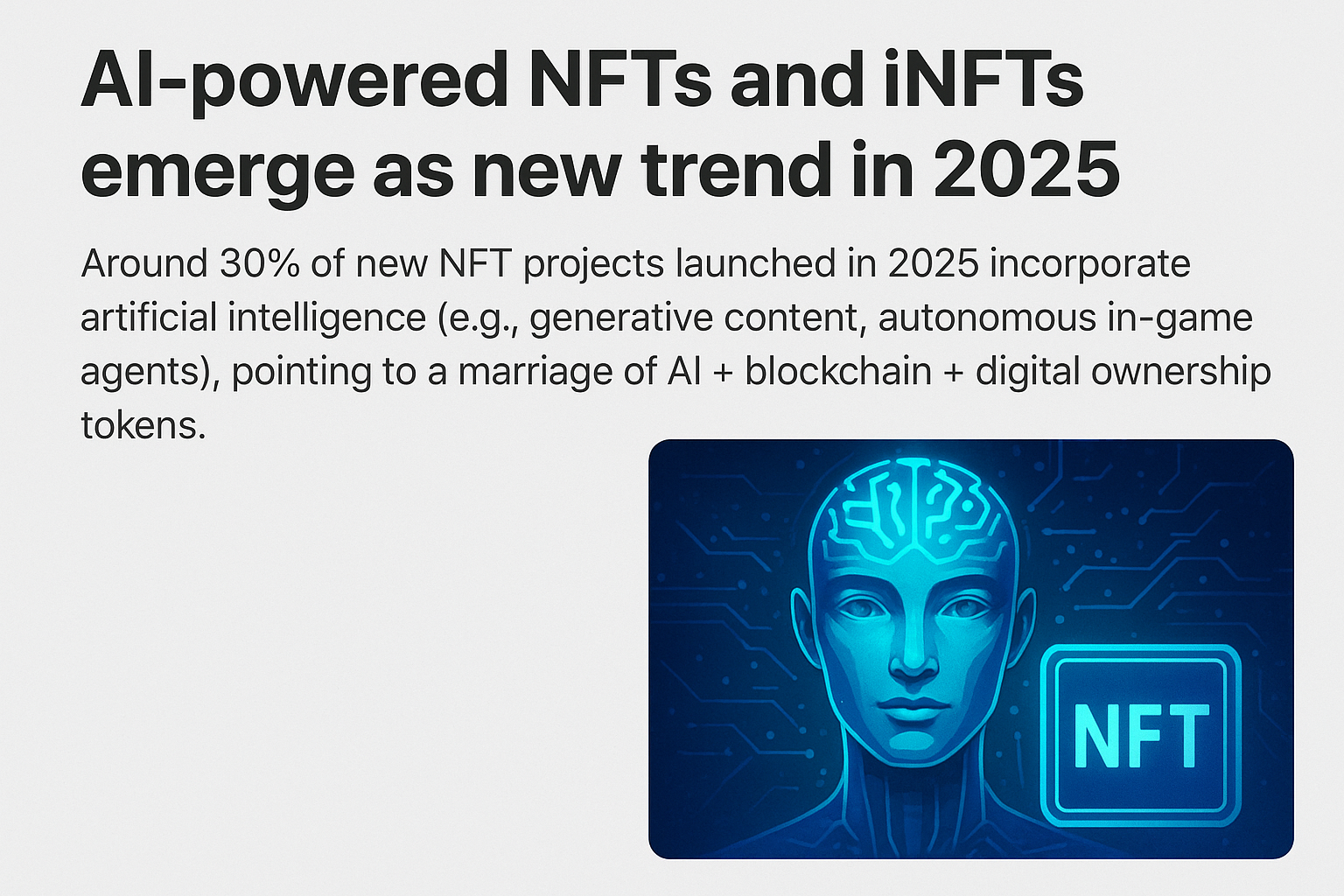The year 2025 is shaping up to be a landmark moment in the evolution of digital ownership. What began as a speculative boom around simple JPEG collectibles has now transformed into something far more sophisticated: AI-powered NFTs and the rise of iNFTs (intelligent NFTs). These next-generation digital assets blend artificial intelligence with blockchain technology to create dynamic, autonomous, and interactive digital entities.
According to industry data, around 30% of all new NFT projects launched in 2025 now incorporate AI, whether through generative content engines, intelligent in-game agents, evolving artwork, or adaptive digital characters. This rapid integration signals a tectonic shift in how creators, developers, and collectors envision the future of Web3.
From Static Collectibles to Living Digital Assets
Early NFTs were immutable, unchanging tokens that simply pointed to an image or a piece of metadata. AI-powered NFTs break that mold.
Today’s AI-enhanced NFTs can:
-
Learn from user interactions
-
Adapt their visual or behavioral traits over time
-
Generate new content autonomously
-
Participate in virtual worlds as independent agents
-
Evolve based on on-chain or off-chain triggers
-
Act as personalized digital companions
This new generation of assets transforms NFTs from static property into dynamic digital beings.
The shift from NFT to iNFT mirrors the broader movement across Web3: assets that don’t just exist, but think, respond, and grow.
Generative AI + Blockchain: A Perfect Match
The momentum behind AI-powered NFTs is driven by the natural synergy between both technologies:
-
AI provides creativity, adaptability, and intelligence.
-
Blockchain provides ownership, transparency, and provable history.
Together, they enable something entirely new:
Digital items that evolve while remaining verifiably owned and authenticated on-chain.
For example, an AI NFT artwork might slowly shift its style based on market sentiment, the owner’s wallet activity, or global events—yet the blockchain will record each transformation in a permanent, tamper-proof log.
Gaming: The First Big Use Case
In 2025, gaming studios have become some of the most aggressive adopters of AI-driven NFTs.
Players can now own:
-
Autonomous in-game companions
-
AI-driven NPCs that develop personalities
-
Dynamic weapons or items that level up based on how they’re used
-
Game characters that continue to evolve even when the player is offline
These intelligent assets deepen gameplay and create attachment, while also offering secondary market value through rarity, uniqueness, and progression.
Evolving Digital Identities and Avatars
Another fast-growing category is AI-powered avatars.
Users can now create iNFTs that:
-
Speak with AI-generated voices
-
Hold basic conversations
-
Develop memories over time
-
Serve as personal brand ambassadors in the metaverse
These avatars bridge identity, creativity, and ownership in ways that were impossible even a few years ago.
What’s Driving Adoption?
Several major trends accelerated the rise of AI NFTs in 2025:
-
Explosion of generative AI tools
Easy-to-use models empower creators to generate interactive NFTs without coding. -
Mainstream infusion of Web3 infrastructure
Scalable, low-fee blockchains make AI integration more practical. -
Growing demand for immersive digital ownership
Users want assets that feel alive, not static. -
Institutional and enterprise adoption
Brands explore AI-driven collectible ecosystems with evolving loyalty rewards.
Challenges Ahead
Despite the hype, AI-powered NFTs face real challenges:
-
High computational cost
Running AI models on-chain is still expensive. -
Data ownership and privacy
How should AI training data be stored—and who owns it? -
Regulatory uncertainty
As NFTs become autonomous agents, new legal questions emerge. -
Scalability
iNFTs require enormous amounts of metadata and computation.
Still, developers are building solutions, from hybrid on/off-chain AI processing to new standards for dynamic NFTs.
What Comes Next?
2025 is only the beginning. Analysts predict the next wave will include:
-
Self-governing iNFTs with DAO-like decision-making
-
AI-powered marketplaces where NFTs negotiate trades
-
Cross-world intelligent assets synced across multiple games/metaverses
-
Adaptive loyalty programs powered by AI avatars
-
iNFT-based entertainment franchises
As AI continues to evolve, so too will the NFTs built on top of it. The convergence of artificial intelligence, blockchain, and digital ownership is setting the stage for an entirely new category of online life.
AI-powered NFTs and iNFTs represent one of the most significant evolutions in Web3 since the invention of the ERC-721 token. With nearly one-third of 2025’s new NFT projects incorporating AI, the trend is not only growing—it’s becoming the new standard.
NFTs are no longer just digital collectibles.
They are becoming interactive, intelligent digital companions.




